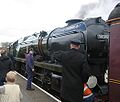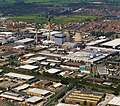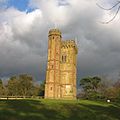Portal:South East England
The South East England Portal

South East England is one of the nine official regions of England in the United Kingdom at the first level of ITL for statistical purposes. It consists of the counties of Buckinghamshire, East Sussex, Hampshire, the Isle of Wight, Kent, Oxfordshire, Berkshire, Surrey and West Sussex. Major towns and cities in the region include Brighton and Hove, Canterbury, Milton Keynes, Southampton, Portsmouth, Slough, Reading and Oxford.
South East England is the third-largest region of England, with a land area of 19,072 square kilometres (7,364 sq mi), and is also the most populous with a total population of over nine million. The region contains eight legally chartered cities: Brighton and Hove, Canterbury, Chichester, Milton Keynes, Oxford, Portsmouth, Southampton and Winchester. The region's close proximity to London has led to South East England becoming a prosperous economic hub with the largest economy of any region in the UK, after London. The region is home to Gatwick Airport, the UK's second-busiest airport, and Heathrow Airport (the UK's busiest airport) is located adjacent to the region's boundary with Greater London. The coastline along the English Channel provides numerous ferry crossings to mainland Europe.
The region is known for its countryside, which includes two national parks: the New Forest and the South Downs, as well as the North Downs, the Chiltern Hills and part of the Cotswolds. The River Thames flows through the region and its basin is known as the Thames Valley. It is also the location of a number of internationally known places of interest, such as HMS Victory in Portsmouth, Cliveden in Buckinghamshire, Thorpe Park and RHS Wisley in Surrey, Blenheim Palace in Oxfordshire, Windsor Castle in Berkshire, Leeds Castle, the White Cliffs of Dover and Canterbury Cathedral in Kent, Brighton Palace Pier, and Hammerwood Park in East Sussex, and Wakehurst Place in West Sussex. The region has many universities; the University of Oxford is the oldest in the English-speaking world, and ranked among the best in the world.
South East England is host to various sporting events, including the annual Henley Royal Regatta, Royal Ascot and The Derby, and sporting venues include Wentworth Golf Club and Brands Hatch. Some of the events of the 2012 Summer Olympics were held in the south east, including the rowing at Eton Dorney and part of the cycling road race in the Surrey Hills.
In medieval times, South East England included much of the Kingdom of Wessex, which was the precursor to the modern state of England. Winchester was the capital of England after unification of the various states, including the kingdoms of Kent, Sussex and Mercia. Winchester stopped being the administrative capital of England some time in the 13th century as its influence waned while the City of London dominated commerce. The last monarch to be crowned at Winchester was Richard II in 1377, although the last monarch to be crowned by the Bishop of Winchester was Queen Mary I in 1553. (Full article...)
Selected article
Waddesdon Road railway station, called Waddesdon railway station before 1922, was a small halt in open countryside in Buckinghamshire, England. It was opened in 1871 as part of a short horse-drawn tramway to assist with the transport of goods from and around the Duke of Buckingham's extensive estates in Buckinghamshire and to connect the Duke's estates to the Aylesbury and Buckingham Railway at Quainton Road. In 1872 the line was expanded and converted for passenger use, becoming known as the Brill Tramway. In 1899 the operation of the line was taken over by the London-based Metropolitan Railway.
In 1933 the Metropolitan Railway was taken into public ownership to become the Metropolitan line of the London Underground, and despite its rural setting Waddesdon Road station became a part of the London Transport system. The new management could not see a future for the line as a financially viable passenger route, and Waddesdon Road, along with the rest of the former Brill Tramway, was closed in late 1935.
The station was heavily used for the transport of construction materials during the building of Baron Ferdinand de Rothschild's estate at Waddesdon Manor in the 1870s and 1880s, but aside from that it saw little use. The station was inconveniently sited and served by few passenger trains, and other more frequently served stations were in easy walking distance. In 1932, the last full year of operations prior to the Metropolitan Railway being taken into public ownership, the station was used for only 281 passenger journeys and generated just £4 of passenger revenue. (Full article...)
Selected pictures
Selected biography
Frank Arthur "Bones" Jenner (surname often misspelled Genor; 2 November 1903 – 8 May 1977) was an Australian evangelist. His signature approach to evangelism was to ask people on George Street, Sydney, "If you died within 24 hours, where would you be in eternity? Heaven or hell?" Born and raised in England, he contracted African trypanosomiasis at the age of twelve and suffered from narcolepsy for the rest of his life. After some time, he joined the Royal Navy, but deserted in New York and joined the United States Navy. When he was 24, he deserted again while in Australia. He subsequently worked for the Royal Australian Navy until he bought his way out in 1937.
That year, Jenner encountered a group of men from the Glanton Exclusive Brethren who were engaging in open-air preaching, and he converted to Christianity. For 28 years, from his initial conversion until his debility from Parkinson's disease, Jenner engaged in personal evangelism, probably speaking with more than 100,000 people in total. One person who became a Christian after encountering Jenner's question was Noel Stanton, who went on to found the Jesus Army in 1969.
In 1952, the Reverend Francis Dixon of Lansdowne Baptist Church in Bournemouth, England, began hearing several testimonies from people who became Christians after Jenner accosted them on George Street, Sydney. The following year, Dixon met with Jenner in Australia and told him about the people he had met who had become Christians as a result of Jenner's evangelism, and Jenner, then fifty years old, cried because he had not previously known that even one of the people he had talked to had remained a Christian beyond their initial profession of faith.
Jenner died from colorectal cancer in 1977. While he was alive, very few people knew of him, but after he died, stories of his evangelistic activities circulated widely, and elements of some of these stories contradicted others. In 2000, Raymond Wilson published Jenner of George Street: Sydney's Soul-Winning Sailor in an attempt to tell the story of Jenner's life accurately. Nonetheless, conflicting accounts of Jenner's life have continued to propagate, including an account from Ché Ahn in which Jenner is referred to as "Mr. Genor". (Full article...)
On This Day in South East England
29 May:
1982: In the first Papal visit to Britain since 1531, Pope Paul II prayed alongside the Archbishop of Canterbury, the head of the Church of England, at Canterbury Cathedral.
Categories
Related portals
WikiProjects
Topics
Associated Wikimedia
The following Wikimedia Foundation sister projects provide more on this subject:
-
Commons
Free media repository -
Wikibooks
Free textbooks and manuals -
Wikidata
Free knowledge base -
Wikinews
Free-content news -
Wikiquote
Collection of quotations -
Wikisource
Free-content library -
Wikiversity
Free learning tools -
Wikivoyage
Free travel guide -
Wiktionary
Dictionary and thesaurus
































































































































